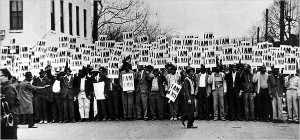I met Withers at a commemorative march for Dr. King on the anniversary of the assassination, April 4, some years ago in Memphis. He saw our banner for the Coalition on Political Assassinations and our call to release the files on Dr. King from the House Select Committee on Assassinations. He was angry and adamant that there was no conspiracy to kill Dr. King and that the files should remain closed to protect Dr. King. Researcher Lyndon Barsten also recalls a visit to Invaders activist Charles Cabbage in Memphis and a call from Withers during his interview to Cabbage. This was before the last appeal trail afforded to James Earl Ray before Judge Joe Brown and Withers was adamant again that Ray should never be afforded any new trials, an opinion that confused Barsten. Now we both know why Withers so angrily opposed the truth being revealed. This recent release to the Commercial Appeal of unredacted records and agent identify numbers that could finally be matched to Withers and then to earlier documents and reports from 30 years ago underlines the need to introduce the Rev. Martin Luther King, Jr. Records Act to effect the release of all the files held by Congress and the Executive Branch agencies, as well as state, local, court and international classified files on the life and death of Dr. King. Our history belongs to us not to those with something to hide so many decades later. COPA is working with the offices of Senator Kerry, Rep. John Lewis and the appropriate House and Senate subcommittees and committees that would hold hearings on and pass such legislation to the floor, years after it was drafted in the 109th Congress by Rep. Cynthia McKinney. The King family, the civil rights leaders still with us, the national African American community and anyone who cherishes the truth and the real hidden history of this country in regard to Dr. King should welcome such a release of files in full. It will unquestionably embarrass and expose the informants who were betraying him far more than it could damage the reputation of Dr. King and reveal his role as a victim and target of a corrupted military-industrial-
Chronicler and informant: Ernest C. Withers is shown in 1968 in front of his Beale Street studio. That same year, the respected chronicler of the civil rights era passed photographs and information to a now-defunct wing of the FBI that was spying on Americans. (©
Ernest C. Withers Trust, courtesy Decaneas Archive, Boston, Mass.)At the top of the stairs he saw the blood, a large pool of it, splashed across the balcony like a grisly, abstract painting. Instinctively, Ernest Withers raised his camera. This wasn’t just a murder. This was history.
Dr. Martin Luther King Jr. stood here a few hours earlier chatting with aides when a sniper squeezed off a shot from a hunting rifle. Now, as night set over Memphis, Withers was on the story. Slipping past a police barricade, the enterprising Beale Street newsman made his way to room 306 at the Lorraine Motel — King’s room — and walked in. Ralph Abernathy and the others hardly blinked. After all, this was Ernest C. Withers. He’d marched with King, and sat in on some of the movement’s sensitive strategy meetings.
A veteran freelancer for America’s black press, Withers was known as “the original civil rights photographer,” an insider who’d covered it all, from the Emmett Till murder that jump-started the movement in 1955 to the Little Rock school crisis, the integration of Ole Miss and, now, the 1968 sanitation strike that brought King to Memphis and his death.
As other journalists languished in the Lorraine courtyard, Withers’ camera captured the scene:
Bernard Lee, tie undone, looking weary yet fiery. Andrew Young raising his palm to keep order. Ben Hooks and Harold Middlebrook gazing pensively as King’s briefcase sits nearby, opened, as if awaiting his return.
The grief-stricken aides photographed by Withers on April 4, 1968, had no clue, but the man they invited in that night was an FBI informant — evidence of how far the agency went to spy on private citizens in Memphis during one of the nation’s most volatile periods.

